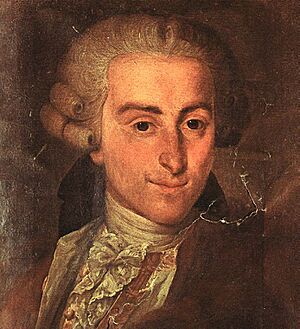Giovanni Battista Sammartini facts for kids
Giovanni Battista Sammartini (born around 1700 – died January 15, 1775) was a very important Italian composer. He was also a talented violinist, organist, choirmaster, and teacher. Many famous composers learned from him, including Gluck. Younger composers like Johann Christian Bach also admired his work.
Sammartini is especially known for helping to create the modern symphony. Before him, symphonies were often short pieces played before an opera. He made them longer, more serious, and developed musical themes in new ways. This style helped pave the way for later famous composers like Haydn and Mozart. Some of his music is called galant, which was a popular style during the Enlightenment. His work greatly helped shape the Classical music style.
Sometimes, people confuse him with his older brother, Giuseppe. Giuseppe was also a composer, but Giovanni Battista was more famous and had a bigger influence on music.
Contents
Sammartini's Life Story
Giovanni Battista Sammartini was born in Milan, Italy, around 1700. At that time, Milan was part of a region called Lombardy, which was ruled by the Habsburg family. His father, Alexis Saint-Martin, was a French oboe player.
Giovanni was the seventh of eight children. He learned music from his father. He wrote his first musical pieces, which were songs, in 1725, but these are now lost. In 1728, he got important jobs as a music director (called maestro di cappella) at the Sant'Ambrogio church and for a religious group. He kept the job at Sant'Ambrogio until he died.
Sammartini quickly became known for his church music. His fame spread to other countries. Over his life, he worked for many churches, possibly eight or more. He also wrote music for special events and for noble families. Even though he didn't travel far from Milan, he met many other famous composers. These included J.C. Bach, Mozart, Boccherini, and Gluck. Gluck was even his student from 1737 to 1741.
Sammartini died suddenly in 1775. Although he was highly respected when he was alive, his music was soon forgotten. It wasn't until 1913 that researchers rediscovered many of his works. Interestingly, most of his surviving music was found in copies published outside Milan.
How Sammartini Changed Music
Sammartini is most praised for his new ideas in developing the symphony. Some people think his ideas were even more important than those from the Mannheim or Vienna groups of composers.
His way of writing symphonies was special. He took ideas from trio sonatas and concertos. Other composers at the time often based their symphonies on short opera openings called overtures. Sammartini's symphonies had strong rhythms and clearer forms. He used early sonata form and rounded binary form. His music was always creative. Sometimes, it even showed what classical music would be like in the future, such as the Sturm und Drang style. A Czech composer named Josef Mysliveček called Sammartini "the father of Haydn's style." This idea helped Sammartini's reputation grow after he died.
Sammartini's Compositions
Sammartini wrote a lot of music! His works include 4 operas, about 70 symphonies, and ten concertos. He also wrote many pieces for small groups of instruments (chamber music). By 2004, about 450 of his known works had been found. However, a good amount of his music, especially church music and dramatic works, has been lost. Some of his music might have been published under other names, even his brother Giuseppe's. His earliest music was written for church services.
Sammartini's music is often grouped into three periods based on his style:
- The early period (1724–1739) mixes older Baroque styles with newer Preclassical forms.
- The middle period (1740–1758) shows more of the Preclassical style.
- The late period (1759–1774) has clear Classical influences.
His middle period is seen as his most important and groundbreaking. During this time, his galant style music gave hints of the Classical era that was coming.
Types of Music Sammartini Wrote
- Symphonies (78)
- Concertos (10 or 11):
- For flute
- For violin
- For cello
- For oboe
- Concertinos (7)
- Marches (4)
- Minuets (4)
- String quintets (6)
- Flute and string quartets (27)
- String trios (~177)
- Sonatas (over 50):
- For flute
- For violin
- For cello
- For keyboard (harpsichord and organ)
- For mandolin (1)
- Operas (3):
- Memet (1732)
- L'ambizione superata dalla virtù (1734)
- L'Agrippina, moglie di Tiberio (1743)
- Arias and vocal ensemble pieces (11)
- Cantatas (8)
- Oratorio (1):
- La gara dei geni (1747)
- Sacred works (16):
- Mass settings
- Psalm settings
- Litanies
- Magnificat
- Te Deum
See also
 In Spanish: Giovanni Battista Sammartini para niños
In Spanish: Giovanni Battista Sammartini para niños


